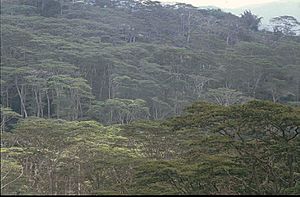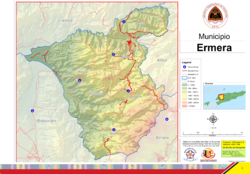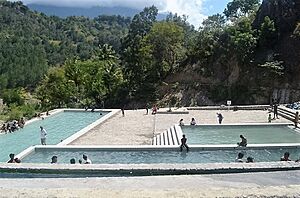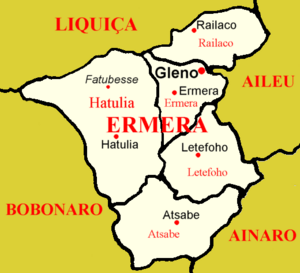Ermera Municipality facts for kids
Quick facts for kids
Ermera
|
||
|---|---|---|
|
||

Ermera
|
||
|
||

|
||
|
OpenStreetMap
|
||
| Country | ||
| Capital | Gleno | |
| Administrative posts |
|
|
| Area | ||
| • Total | 756.5 km2 (292.1 sq mi) | |
| Area rank | 10th | |
| Population
(2015 census)
|
||
| • Total | 125,702 | |
| • Rank | 2nd | |
| • Density | 166.163/km2 (430.359/sq mi) | |
| • Density rank | 2nd | |
| Households (2015 census) | ||
| • Total | 20,671 | |
| • Rank | 3rd | |
| Time zone | UTC+09:00 (TLT) | |
| ISO 3166 code | TL-ER | |
| HDI (2017) | 0.562 medium · 11th |
|
Ermera (Portuguese: Município Ermera, Tetum: Munisípiu Ermera) is one of the municipalities (formerly districts) of East Timor, located in the west-central part of the country. It has a population of 117,064 (Census 2010) and an area of 756.5 km2.
Contents
Etymology
The word Ermera means 'red water' in the local Mambai language. It is said that the ancestors of today's inhabitants of the municipality originated from three mountains, namely Cailitlau, Lalimlau, and Hituria, and that the name Ermera refers to the red waters flowing from those mountains.
Geography
Ermera is one of only two land-locked municipalities in East Timor, the other being Aileu. It borders Liquiçá to the north, Dili to the northeast, Alieu to the east, Ainaro to the southeast, and Bobonaro to the west.
The boundaries of the municipality are identical to those of the district of the same name in Portuguese Timor. Its capital is Gleno, which is located 30 km to the southwest of the national capital, Dili. The city of Ermera, also known as Vila Ermera, lies 58 km from the capital along the same road. In Marobo (Atsabe Administrative Post) are the remains of a hot springs bath from colonial times. The pool is still in use.
Administrative posts
The municipality's administrative posts (formerly sub-districts) are:
- Atsabe Administrative Post
- Ermera Administrative Post
- Hatulia Administrative Post
- Hatulia B Administrative Post
- Letefoho Administrative Post
- Railaco Administrative Post
The administrative posts are divided into 52 sucos ("villages") in total.
See also
 In Spanish: Distrito de Ermera para niños
In Spanish: Distrito de Ermera para niños





